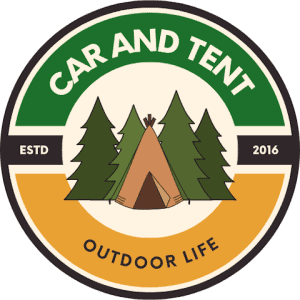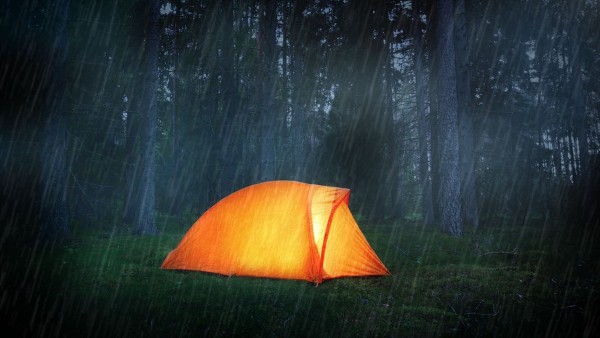Car camping in the rain can be quite fun, but it does bring with it a few challenges. In this post, we’ll go over everything you need to know before you go camping in the rain.
Table of Contents
Prepare Your Tent for The Rain
One of the first steps you’ll want to take before heading to your campsite is to make sure that your tent is properly prepared for the rain. A waterproof tent isn’t always as waterproof as you may think. Seams can leak, sides can leak, and water can come right through the bottom.
Here is how to stop this from happening:
- Apply seam sealer to all of your tent’s seams.
- Add a footprint to the outside of your tent.
- Put up your rain fly.
Before heading out, you’ll want to make sure you’ve applied seam sealer to the seams of your tent. This is especially important on older tents where your seams may not be as tight as they once were.
You’ll also want to get a footprint for your tent. A footprint is a tent-like material that is placed underneath of your tent to help keep water off of the bottom of your tent. It also helps to give the bottom of the tent some extra protection against rocks and jagged areas of the ground that could potentially put holes and tears in your tent.
A tent footprint can be as simple as a small tarp on the ground although you can buy one from most tent manufacturers. Just be careful when it rains as a tent footprint can sometimes hold water so you may want to remove it if you see water pooling up underneath.
If your tent has a rain fly, you’ll definitely want to put it up. Remember, to use your guylines to keep the rain fly up and off of your tent. This will help reduce condensation from forming inside your tent.
If you don’t have a rain fly, you can set a tarp up over your tent. Just make sure you leave space between the tarp and your tent.
Tent Location
Car camping in the rain means you’ll have to be careful where you setup your tent. Set your tent up away from dead trees, rock outcroppings, and obvious water channels. The highest point in your camp site is often-times the best as water is less likely to pool up if it has a place to run to.
In addition to setting up your tent away from areas that may flood, you may also want to set it up away from any tree branches that might come down during a rainstorm. A tent might protect you from the rain but it won’t be much help in the event that a tree branch falls. If possible, set your tent up away from any large or dead tree branches.
Sleep in Your Vehicle
If it’s large enough, consider turning your car into your tent. Assuming your vehicle doesn’t leak, you’ll have a nice dry area to sleep in at night. Minivans, SUVs, crossovers, and wagons make great car camping vehicles.
While we’re on the topic of vehicles, make sure to bring some tarps to place your wet gear on before heading home. There is nothing worse than having to load up mud-laden gear into the back of your car. Throw some tarps down and you won’t have to worry so much.
Extend Your Campsite
Tarps can be used to extend the amount of rain cover you have and camp furniture can ensure that you’ll have a dry place to sit. Just be sure to pack enough rope, poles, and rods to secure your tarps or you may end up having to chase after them.
Any standalone canopies should be staked to the ground or weighed down with dirt or sandbags. Camping chairs should be folded up and put away when not in use. With rain often comes strong winds and you don’t want your chairs blowing into your tent.
Pack the Right Clothing
A nice poncho with a hood and a set of wet weather pants will give you the ability to get out on the trails whether it’s raining or not.
This being said, wet weather gear isn’t always perfect and even if it keeps every drop of rain from touching you, you’ll probably still end up wet anyway. The reason for this is that the same properties that make rain gear so great at keeping water out also make it great at keeping water in. This is all just a long way of saying you’re going to sweat a lot in your rain gear.
Pack extra clothes so that you can change out of your sweaty ones on a regular basis. You’ll be more comfortable and your tent-mates will thank you for it.
Pack Weatherproof Footwear
You can buy hiking shoes and boots that are already weatherproof or you can spray your footwear with a waterproofing spray to make them waterproof.
Another option is to buy overshoes or overboots. These are essentially rubber shoes that go over your shoes. They act as a protective layer so that your actual shoes do not get wet.
Overshoes work great at keeping feet dry, but they do have a couple of downsides.
For instance, an overshoe typically will not provide the traction that a hiking shoe provides. This makes overshoes less than ideal for hiking in slippery or rugged terrain.
Additionally, overshoes do not let your feet “breathe”. This means your feet are going to sweat, A LOT. If you plan to wear overshoes, plan to bring a lot of socks. Trench foot is serious and can even be brought on through sweaty feet.
Another option would be to bring some form of aquatic shoes. A good set of aquatic shoes will give you the ability to ditch the socks during your day hikes. When you get back to camp, you can take them off, dry your feet, and put on a nice warm pair of socks and camp slippers.
Camp Lighting
Car camping in the rain always involves clouds and dreary weather. Bring your camp to life and make it brighter by packing extra lighting. String lighting, tent lights, and lanterns will help brighten an otherwise dreary vacation.
These lights will also help extend daylight hours as it tends to get dark quicker on cloudy days. While a camping trip might be a fun way to catch up on some sleep, it doesn’t have to be.
Cooking When Your Car Camping in The Rain
When you’re car camping in the rain, you may not be able to cook over an open fire pit. Bring your own gas or alcohol burner and you won’t have to worry about eating cold food.
Also, be sure you bring your own firewood. Even if the rain has stopped, the nearby wood will all be wet. Wet firewood is hard to light and makes for a smokey fire.
Camp Food
Good food is always important, but it’s even more important when car camping in the rain. A nice soup or stew is always comforting when you’ve been out in the rain all day. Also, pack some food you don’t have to cook. If the rain and wind are bad enough, you may not want to have to leave the comfort of your tent to cook.
Also, never cook inside your tent. Not only does this attract animals but it causes condensation. If you’re unfamiliar with how condensation affects your tent, see my post titled, “Why Does the Inside of My Tent Get Wet“.
Bring the Heat
A cold rain can really bring the temperature down quickly. Pack extra blankets and hand warmers. Getting a cold in the Summer isn’t any easier than getting one in the Winter.
If you think it will get especially cold inside of your tent, you may even want to consider bringing a tent heater. There are a few different types of heaters that you can use that are safe for tents.
Read more about this at https://www.carandtent.com/are-camping-heaters-safe/
Pack Some Things to Do
The rain can ruin a lot of activities that you may otherwise have been able to do. Pack books, board games, tablets, cards, and anything else that you can think of to entertain yourself with. You’d be surprised how quickly a day can drag on when you don’t have anything to busy yourself with.
If you’re camping by yourself, feel free to bring some paper to start on that novel you’ve always been thinking about writing. A rainy day in the woods might be just the inspiration you need to get started.
Be Prepared to Leave Early
If you’re camping buddies all want to go home, it is best to let them. Forcing your friends and family members to stay on a trip they are unhappy with will only ensure that they won’t come next year. Keep them happy and keep them coming back – there is always next year!
When You Get Home
When you get home, you’ll want to make sure you properly dry out all of your gear. On the first sunny day, set your tent back up outside in the sun and let it dry out. This will keep mold and mildew from forming and will give you a chance to properly clean it.
In case you’re curious, tents are not machine washable. For more details on cleaning your tent, visit https://www.carandtent.com/are-camping-tents-machine-washable/


